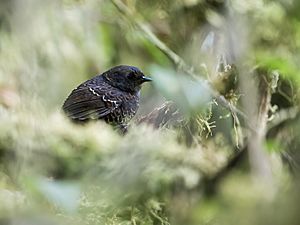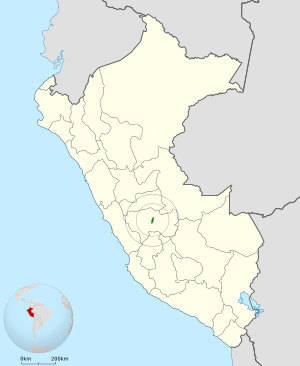Junin tapaculo facts for kids
Quick facts for kids Junin tapaculo |
|
|---|---|
 |
|
| Conservation status | |
| Scientific classification | |
| Genus: |
Scytalopus
|
| Species: |
gettyae
|
 |
|
The Junin tapaculo (scientific name: Scytalopus gettyae) is a small, secretive bird found only in Peru. It belongs to a group of birds called tapaculos. Scientists first discovered this species in 2008, and it was officially described as a new species in 2013.
One special thing about the Junin tapaculo is its unique song. It sings a fast series of rising sounds, which helps scientists tell it apart from other similar birds. The bird's scientific name, gettyae, honors Caroline Marie Getty. She is a nature conservationist who works to protect wildlife.
Contents
What Does the Junin Tapaculo Look Like?
Scientists have studied a few Junin tapaculos to learn about their size. These birds weigh about 19.8 to 20.9 grams, which is about the same as a few quarters. Their beaks are quite small, measuring between 5.9 and 6.6 millimeters long.
Their legs, called tarsi, are about 21.9 to 24.0 millimeters long. The wings measure between 55.0 and 58.8 millimeters. Their tails are about 37.0 to 40.9 millimeters long. These measurements help scientists identify the Junin tapaculo.
Where Does the Junin Tapaculo Live?
The Junin tapaculo lives in the high mountains of Peru. The birds studied were found at elevations between 2,300 meters and 3,200 meters above sea level. This is like living on top of very tall mountains! So far, they have only been found in two places, about 5 kilometers apart, within one river valley.
What is the Junin Tapaculo's Conservation Status?
The Junin tapaculo is not yet listed on the IUCN Red List. This list helps track how endangered different species are. If the Junin tapaculo is only found in these two small areas, it might be considered an endangered species.
However, tapaculos are very shy birds and hard to spot. It's possible they live in more places than scientists currently know. Because there isn't enough information about how many Junin tapaculos exist or where they all live, scientists think it should be listed as "Data Deficient." This means more research is needed to understand its true conservation needs.
See also
 In Spanish: Tapaculo de Junín para niños
In Spanish: Tapaculo de Junín para niños


